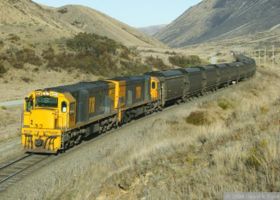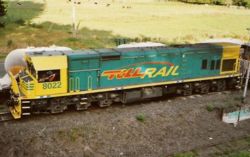NZR DX class
| NZR DX class | |
 Two DX class locomotives on a coal train
| |
| Power type | Diesel-Electric |
|---|---|
| Builder | General Electric, United States |
| Model | U26C DXR: |
| Build date | 1972-1975 |
| UIC classification | Co-Co |
| Gauge | 1067mm |
| Length | 17.9 m |
| Width | 3.013 m |
| Height | 4.296 m |
| Total weight | 97.5 t DXR: 105 t |
| Prime mover | General Electric 7FDL-12 |
| Transmission | 25/64 gear ratio |
| Top speed | 120 km/h |
| Power output | Original: 2050 kW Uprated: 2240 kW |
| Career | New Zealand Railways, Tranz Rail, Toll Rail |
| Number in class | 49 |
| Number | TMS numbers: 5016 - 5520 DXR: 8007, 8022 Early numbers: 2600 - 2648 |
| Nicknames | "Dixies" (DX) "The Pig" (DXR 8007) |
| First run | 1972 DXR: 1993 and 2006 |
| Disposition | 2 rebuilt as DXR (both in service); 1 withdrawn; 46 in service |
The General Electric DX class, consists of forty-nine locomotives built by General Electric of the United States between 1972 and 1975 for the then New Zealand Railways Department. The class is based on the General Electric U26C class, a scaled-down version of the GE U25C class for narrow-gauge railways. This class of locomotive is also used by other narrow-gauge railways in South Africa (Class 34) and Kenya. They were introduced originally to haul heavy freight trains on the North Island Main Trunk during the 1970s, the section of track they were restricted to until other lines in the NZR system were upgraded to handle their greater axle loading. Due to the partial electrification of the NIMT, completed in 1988, and the subsequent introduction of the EF Class electric locomotives, the DX Class were deployed for the first time to the South Island. The class were then used to haul freight on the South Island Main Trunk Railway between Christchurch and Picton (the Main North Line) and Christchurch and Invercargill, the Main South Line.
The locomotives received an upgrade during 1988 with the introduction of single-manning to improve visibility for the driver - this involved a large single front window replacing the original configuration that had two small windows instead.
DXR sub-class
In 1993, New Zealand Rail Limited undertook a significant rebuilding of DX 5362 into the first of what was to be a new sub-class of the locomotives, the DXR class. The use of 'R' (like the DBR Class) denotes that the DX had been rebuilt. The locomotive features a new diesel engine, upgraded traction motors and is of radically different appearance to other DX class locomotives with an enlarged 'Universal Cab'. The DXR class is the most powerful class of diesel-electric locomotive ever operated in New Zealand. The DX rebuilding programme was to be much like the rebuilding of the DF Class into the DFT Class.

However, due to the privatisation of New Zealand Rail Limited (renamed Tranz Rail in 1995) later in 1993, the new management decided not to undertake further DX class rebuilds. Following on from the purchase of Tranz Rail by Toll NZ in 2003, the new management authorised the rebuild of DX 5235, which became DXR 8022. The new DXR did not follow the same lines as the previous locomotive, and in 2006 DXR 8007 was again rebuilt at the Hutt Workshops more closely along the lines of the newer DXR.
Other sub-classes
The classifications DXB, DXC, and DXH are subclasses with a number of other modifications that have been carried out to the fleet. These modifications include modified air intakes, heavier drawgear, electronic traction control systems, uprated engines, new cabs, DC class-style low short hoods and higher power traction motors. The main purpose of these modifications has been to enable the class to be used on the Midland line between Lyttelton and Greymouth in the South Island; particularly in the difficult 8.5km Otira - Arthur's Pass Otira Tunnel section, which was formerly electrified.
External links
References
- Parsons, David - New Zealand Railway Motive Power 2002 [1]

